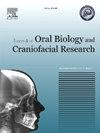富白细胞-血小板纤维蛋白(L-PRF)塞加速年轻人上颌犬后缩的疗效:一项裂口随机对照试验
Q1 Medicine
Journal of oral biology and craniofacial research
Pub Date : 2025-06-30
DOI:10.1016/j.jobcr.2025.06.023
引用次数: 0
摘要
目的评价综合正畸治疗中L-PRF塞对上颌犬齿后缩率的影响。材料与方法本研究纳入15例女性患者,年龄18-25岁,需要全部拔除第一前磨牙矫正错牙合。每例患者的左右上颌弓随机分为对照侧和实验侧。在对照侧第一前磨牙拔除后,在实验侧第一前磨牙拔除槽上放置L-PRF塞,立即开始犬同时内收。通过拔除第一前臼齿并放置L-PRF后1周(T1)、2周(T2)、4周(T3)和8周(T4)制备的上颌研究模型的3D模型来评估犬齿内伸量。在T0、T1、T2、T3和T4时测定GCF中IL-6的浓度。结果15名参与者中,1名在随访期间丢失。对14个上颌弓(14个实验侧和14个对照侧)的数据进行分析。观察前4周,实验侧犬齿内缩较多,为0.25 mm (P = 0.001)。IL-6在实验侧和对照侧犬的中端和远端平均浓度相当(P >;0.05)。在T1 (P = 0.004)和T2 (P = 0.030)时,实验侧犬远端IL-6浓度明显高于中端。IL-6水平与犬的内收量无相关性。在八周的研究期间,没有观察到任何患者的不良反应。结论虽然L-PRF的应用在8周内使上颌犬齿内缩加速了0.32 mm,且大部分加速发生在前4周,但在缩短正畸治疗总时间方面无临床意义。本文章由计算机程序翻译,如有差异,请以英文原文为准。
Efficacy of leukocyte-platelet rich fibrin (L-PRF) plug in accelerating the maxillary canine retraction in young adults: A split mouth randomized controlled trial
Objective
To evaluate the effect of the L-PRF plug on the rate of maxillary canine retraction during the comprehensive orthodontic treatment.
Materials and methods
The present split-mouth randomized controlled trial included 15 female patients (age range, 18–25 yrs) requiring all 1st premolars extraction for correction of their malocclusion. Right and left sides of the maxillary arch in each patient were randomly allocated to control and experimental sides. Simultaneous canine retraction was initiated immediately after the extraction of 1st premolars on the control side, and placement of L-PRF plugs on the experimental side 1st premolar extraction socket. The amount of canine retraction was evaluated from 3D models of the maxillary study models prepared immediately before (T0), then at 1 week (T1), 2 weeks (T2), 4 weeks (T3), and 8 weeks (T4) after the extraction of first premolars and placement of L-PRF. The concentration of IL-6 in the GCF was estimated at T0, T1, T2, T3, and T4.
Results
Of 15 enrolled, one participant lost during the follow-up. The data of fourteen maxillary arches (14 experimental and 14 control sides) were analyzed. During the first four weeks of observation, the experimental sides had more canine retraction of 0.25 mm (P = 0.001). The mean concentrations of IL-6 at mesial and distal aspects of experimental and control side canines were comparable (P > 0.05). There was a significant increase in IL-6 concentration in the distal compared to the mesial aspects of canine in experimental sides at T1 (P = 0.004) and T2 (P = 0.030). There was no correlation between the IL-6 levels and the amount of canine retraction. No adverse effects to any patient were observed during the eight weeks study period.
Conclusion
Although the application of L-PRF accelerated the maxillary canine retraction by 0.32 mm throughout the eight weeks, with most of the acceleration occurring in the first four weeks, but it was not clinically significant in decreasing the total duration of orthodontic treatment.
求助全文
通过发布文献求助,成功后即可免费获取论文全文。
去求助
来源期刊

Journal of oral biology and craniofacial research
Medicine-Otorhinolaryngology
CiteScore
4.90
自引率
0.00%
发文量
133
审稿时长
167 days
期刊介绍:
Journal of Oral Biology and Craniofacial Research (JOBCR)is the official journal of the Craniofacial Research Foundation (CRF). The journal aims to provide a common platform for both clinical and translational research and to promote interdisciplinary sciences in craniofacial region. JOBCR publishes content that includes diseases, injuries and defects in the head, neck, face, jaws and the hard and soft tissues of the mouth and jaws and face region; diagnosis and medical management of diseases specific to the orofacial tissues and of oral manifestations of systemic diseases; studies on identifying populations at risk of oral disease or in need of specific care, and comparing regional, environmental, social, and access similarities and differences in dental care between populations; diseases of the mouth and related structures like salivary glands, temporomandibular joints, facial muscles and perioral skin; biomedical engineering, tissue engineering and stem cells. The journal publishes reviews, commentaries, peer-reviewed original research articles, short communication, and case reports.
 求助内容:
求助内容: 应助结果提醒方式:
应助结果提醒方式:


